Guitar
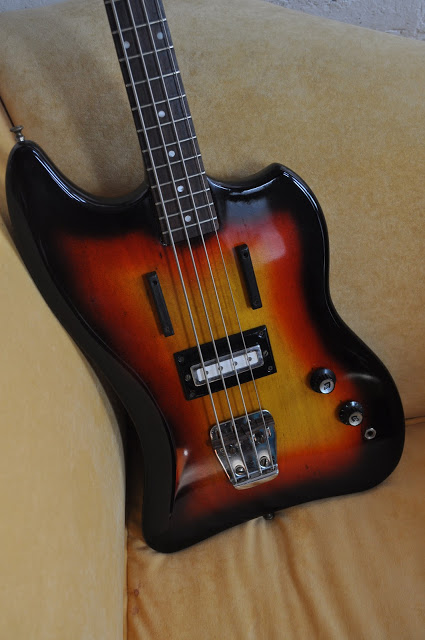
The early Guild Jetstar Bass is one of the rarer and more unusual basses built by the Guild company during their Hoboken, NJ years. Guild was much more of a guitar company to start with - and the semi-hollow Guild Starfire bass was by far the predominant 4-string product during the 1960s.
Its difficult to tell how many Jetstar basses were actually built by Guild, but the numbers were not very large. Using Guild's serial number system and company records, it appears that there were 243 Jetstar Basses built between 1965 and 1967 - with serial numbers ranging between SD 101 and SD 243. There probably were some additional Jetstar Basses built in 1964 and early 1965 under an older Guild serial number system, but there is no way to break out how many from Guild's production records from that period. Does anybody out there have a Jetstar Bass with a non- SD serial number ?
The initial Jetstar Bass built between 1964 and 1965 had an asymmetric headstock with a 2 X 2 tuner configuration. A similar headstock was used on the Guild S-50, S-100 and S-200 guitars. This bass was also fitted with the large Hagstrom BiSonic pickup, as used on the Guild Starfire basses. It doesn't appear that very many examples of this style were built - probably less than 100 and maybe as few as 8. I have never seen one in person, though I do recall seeing a video by the band Cibo Mato where Sean Lennon (John's son) was playing one.
Below is a copy of Guild literature depicting the early model Jet-Star Bass

And here is a picture of the Jet-Star with serial # SD-101 from my buddy Joe O'Quinn - this bass has had the original Hagstrom Bi-Sonic pickup, knobs, Van Ghent/Hagstrom bridge replaced - but the sunburst finish appears to be entirely original.
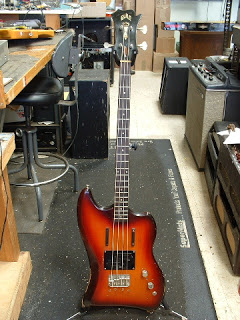
Just needs a Hammon "Darkstar" pickup and some reissue Guild parts to set it right !!
In 1966, Guild switched to a 4-inline tuner configuration, more akin to the Gibson Thunderbird in appearance. Guild also switched to a simpler and smaller DeArmond single coil pickup, often referred to as the "Mickey Mouse pickup", though the initially the Jetstar basses were still routed for the much larger Hagstrom Bisonic pickup. Its not clear if any 4-inline Jetstar Basses came with Bisonics, but it's certainly possible.
Here is a picture of Peter Tork miming bass during a musical sequence of an episode of the Monkees - note the tuners on the headstock - a topic I'll revisit later on. Also note that the finish looks almost like a 50's Fender two-color burst - though this may just be due to the red being washed out in the film clip. The dark border is much wider though than in the example pictured above.
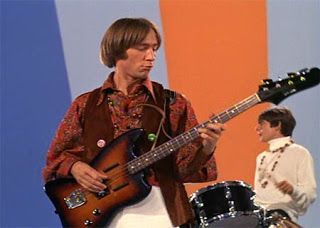
I saw my first Jetstar Bass in person at the Philly Fall Guitar Show back in November 2001 - an example with the finish stripped, but otherwise complete. I opted to buy a really beat and badly refinished '63 Precision instead (they were both $700) but kept my eye open for Jetstar bass.
About 4 years later, I finally found a completely stripped example on Ebay for a pretty reasonable price and bought it. The serial number on the bass was SD 320, meaning it was from late 1966. I fitted a bridge from a Hagstrom "bubble-top" bass in this photo, but it came with absolutely NO parts. Note the remnants of the original yellow undercoat in the pickup cavity.
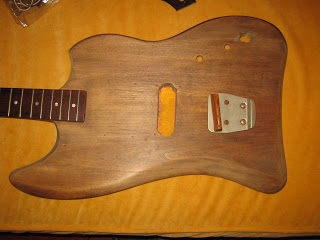
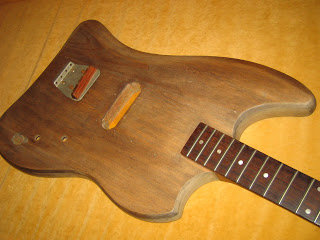
One of the first things I tried to sort out was what kind of tuners were originally fitted to my Jet-Star. My 1965 Guild Starfire has Kluson tuners - similar to those used on Gibson EB-0, EB-2s and EB-3s, but I had also seen pictures of Jet-Stars with Van Ghent/Hagstrom tuners, identical to the ones used on Hagstrom and Baldwin basses during the 60s. Finally - the picture of Peter Tork's Jet-Star appeared to show cheap Japanese tuners - similar to the ones used on Teisco and Sekova basses, as well as some Gibson EB-0s and Melodymaker basses.
Fortunately, I actually examples of all three types of tuners around - and the alignment of the screw holes and relief cuts made it clear that this particular bass was fitted with Kluson tuners - though perhaps models with longer tuner shafts. Given the very limited production of the Jet-Star basses - less than 300 over a 4 year period - I'm pretty sure Guild simply installed whatever was around the shop or easily available on each bass.

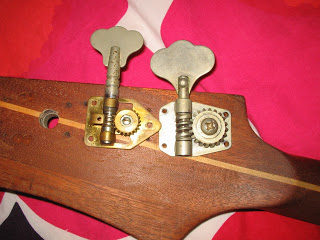
My project didn't really take off though for another few years - when I acquired (from Joe !) another Jet-Star bass - which had at one point been modified to a 5-string (!!) and then unmodified back to a 4-string - leaving a pretty hacked up headstock. But the bass came with the original electronics, control cover, finger rests, knobs and case as well as a compatible Guild bridge - so basically all the parts I was missing for my initial project.

The first order of repair was the output jack area - which had been ripped out at some point. I glued in a fitted piece of alder, with a reinforcing piece of maple underneath it in the control cavity. I filled in the edges with some oak colored filler - and then sanded it smooth and redrilled it later.
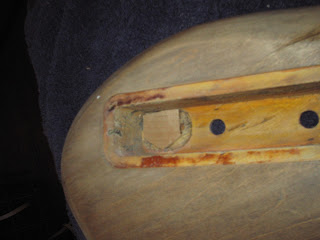
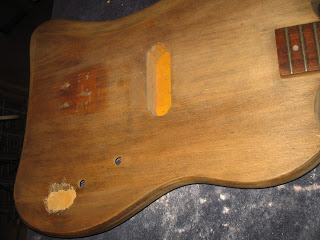
After sanding, the light colored alder body is obvious in contrast to the mahogany neck.
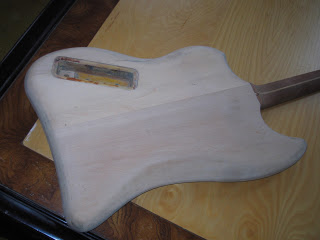



Opted for a three-color sunburst in the Fender style, as opposed to a brown/red/yellow burst. I did this in large part due to a refinish I saw online, which was on a Jet-Star that had the original finish on the neck but not the body. That particular example had a VERY Fender looking 3-color burst on the neck - and the luthier in that case opted for a finish that I felt looked very consistent with the back of the neck. The blogpost can be viewed at here.
The truth is that once again these basses were built in very limited numbers - and as with the hardware - the exact finish applied probably varied from week to week if not example to example.
As with a Fender finish - the first step was a base of transparent lemon yellow. I had to go pretty heavy on the mahogany neck to even get a yellow tint - and it actually had a slight green cast to it, due to the mahogany showing through.
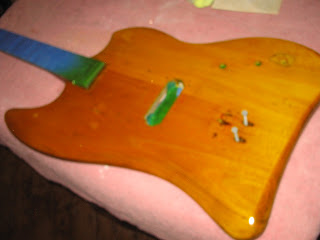

Next came the transparent cherry red - for a "sienna burst" look.
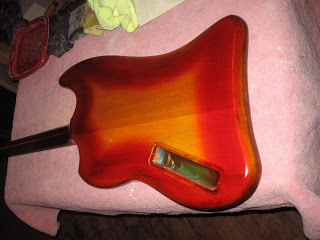
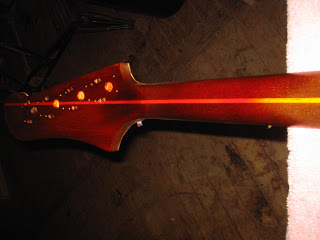
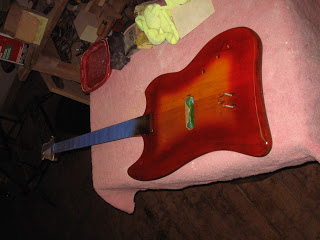
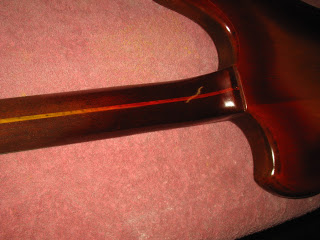
Finally - the walnut edging and detail on the heel and behind the nut on the neck.
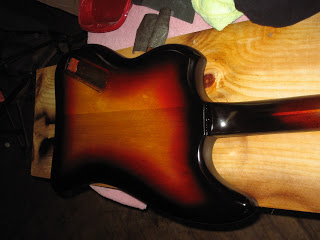
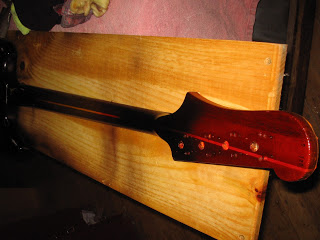
The body then received some touch up of the red part of the burst - over the walnut - and then a number of clear coats to seal in the finish before a wet sanding and buffing out.
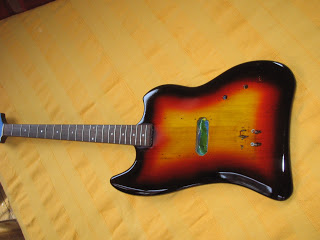
One last step was to transplant new rosewood saddles from a reissue Guild bass to the correct baseplate for the Jet-Star. Of course they didn't completely fit (too tall) - so I had to cut down the metal tabs that allow for each saddle to be adjusted for intonation, then grind down the individual rosewood saddles and assemble everything onto the baseplate.
But finally everything was assembled and setup ...
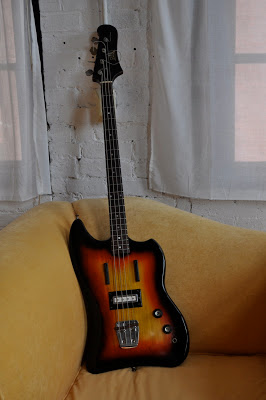
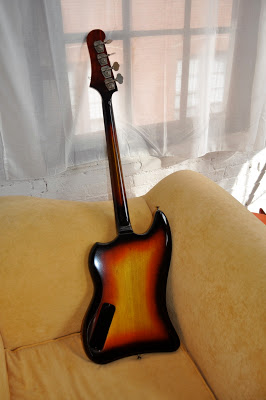
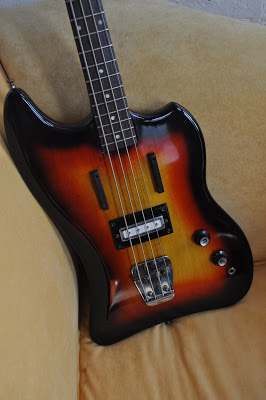
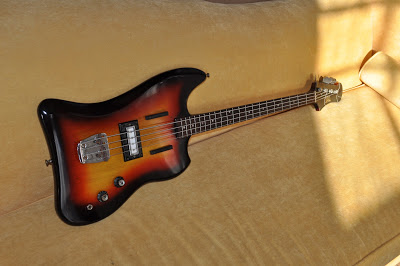
The result is a nice playing, VERY lightweight but balanced bass - this bass has the same compact 30-inch scale length as my Starfire bass and the neck has a very similar profile and feel to it. The bass sounds good despite the cheap little Dearmond pickup - fairly powerful and warm. All I need now is a suede vest, paisley shirt and a bowl haircut ...
So now I need to get started on the other "organ donor" Jet-star bass - which is all mahogany and will be restored to its original cherry red finish. Anyone have a Darkstar or BiSonic pickup for sale out there ??
- Guild 1963 Jetstar S-100 In Nj For $400
Thi is a rare and unique opportunity to purchase a Guild Jestar S-100 from the Original Owner. this is the 2 pickup model with is much less common than the S-50 single pickup version. It has the Hagstrom-type Vibrato tailpiece and the...
- Musicmaster Disaster: Completed
Here's a long overdue follow-up on a post from a few years ago. I started off with an early 70s poplar Fender Musicmaster Bass body that had been mercilessly routed for different pickups and then apparently broken in half and badly reglued together. ...
- 1965 Gibson Sg Junior, Pelham Blue: Completed Finally !!
Roughly four years ago, I acquired a much abused Gibson SG Junior and set about repairing some fairly brutal body routing prior to refinishing it in Pelham Blue. After a few misteps in the refinishing process - I set the project aside. Meanwhile,...
- Sold: 1971 Fender Musicmaster Bass, Daphne Blue
I just finished putting this gorgeous little bass together. I love the Fender Musicmaster Bass and actually use a red 1974 example with flatwounds live with my band. I purchased this one as a project about a year and a half ago, intending to use it with...
- 1960s Guild Starfire Bass Refinish
The other recent project that came my way is a stripped 1968 Guild Starfire bass, which a customer in New York asked me to refinish. We are still pondering exactly what to do with the bass - his preference is to get all remnants of the old finish off...
Guitar
1966 Guild Jetstar Bass: Bringing a "Peter Tork" bass back to life !!

The early Guild Jetstar Bass is one of the rarer and more unusual basses built by the Guild company during their Hoboken, NJ years. Guild was much more of a guitar company to start with - and the semi-hollow Guild Starfire bass was by far the predominant 4-string product during the 1960s.
Its difficult to tell how many Jetstar basses were actually built by Guild, but the numbers were not very large. Using Guild's serial number system and company records, it appears that there were 243 Jetstar Basses built between 1965 and 1967 - with serial numbers ranging between SD 101 and SD 243. There probably were some additional Jetstar Basses built in 1964 and early 1965 under an older Guild serial number system, but there is no way to break out how many from Guild's production records from that period. Does anybody out there have a Jetstar Bass with a non- SD serial number ?
The initial Jetstar Bass built between 1964 and 1965 had an asymmetric headstock with a 2 X 2 tuner configuration. A similar headstock was used on the Guild S-50, S-100 and S-200 guitars. This bass was also fitted with the large Hagstrom BiSonic pickup, as used on the Guild Starfire basses. It doesn't appear that very many examples of this style were built - probably less than 100 and maybe as few as 8. I have never seen one in person, though I do recall seeing a video by the band Cibo Mato where Sean Lennon (John's son) was playing one.
Below is a copy of Guild literature depicting the early model Jet-Star Bass

And here is a picture of the Jet-Star with serial # SD-101 from my buddy Joe O'Quinn - this bass has had the original Hagstrom Bi-Sonic pickup, knobs, Van Ghent/Hagstrom bridge replaced - but the sunburst finish appears to be entirely original.
Just needs a Hammon "Darkstar" pickup and some reissue Guild parts to set it right !!
In 1966, Guild switched to a 4-inline tuner configuration, more akin to the Gibson Thunderbird in appearance. Guild also switched to a simpler and smaller DeArmond single coil pickup, often referred to as the "Mickey Mouse pickup", though the initially the Jetstar basses were still routed for the much larger Hagstrom Bisonic pickup. Its not clear if any 4-inline Jetstar Basses came with Bisonics, but it's certainly possible.
Here is a picture of Peter Tork miming bass during a musical sequence of an episode of the Monkees - note the tuners on the headstock - a topic I'll revisit later on. Also note that the finish looks almost like a 50's Fender two-color burst - though this may just be due to the red being washed out in the film clip. The dark border is much wider though than in the example pictured above.

I saw my first Jetstar Bass in person at the Philly Fall Guitar Show back in November 2001 - an example with the finish stripped, but otherwise complete. I opted to buy a really beat and badly refinished '63 Precision instead (they were both $700) but kept my eye open for Jetstar bass.
About 4 years later, I finally found a completely stripped example on Ebay for a pretty reasonable price and bought it. The serial number on the bass was SD 320, meaning it was from late 1966. I fitted a bridge from a Hagstrom "bubble-top" bass in this photo, but it came with absolutely NO parts. Note the remnants of the original yellow undercoat in the pickup cavity.
One of the first things I tried to sort out was what kind of tuners were originally fitted to my Jet-Star. My 1965 Guild Starfire has Kluson tuners - similar to those used on Gibson EB-0, EB-2s and EB-3s, but I had also seen pictures of Jet-Stars with Van Ghent/Hagstrom tuners, identical to the ones used on Hagstrom and Baldwin basses during the 60s. Finally - the picture of Peter Tork's Jet-Star appeared to show cheap Japanese tuners - similar to the ones used on Teisco and Sekova basses, as well as some Gibson EB-0s and Melodymaker basses.
Fortunately, I actually examples of all three types of tuners around - and the alignment of the screw holes and relief cuts made it clear that this particular bass was fitted with Kluson tuners - though perhaps models with longer tuner shafts. Given the very limited production of the Jet-Star basses - less than 300 over a 4 year period - I'm pretty sure Guild simply installed whatever was around the shop or easily available on each bass.
My project didn't really take off though for another few years - when I acquired (from Joe !) another Jet-Star bass - which had at one point been modified to a 5-string (!!) and then unmodified back to a 4-string - leaving a pretty hacked up headstock. But the bass came with the original electronics, control cover, finger rests, knobs and case as well as a compatible Guild bridge - so basically all the parts I was missing for my initial project.
The first order of repair was the output jack area - which had been ripped out at some point. I glued in a fitted piece of alder, with a reinforcing piece of maple underneath it in the control cavity. I filled in the edges with some oak colored filler - and then sanded it smooth and redrilled it later.
After sanding, the light colored alder body is obvious in contrast to the mahogany neck.
Here's the bodied sanded and with a coat of sanding sealer on it - the jack repair is visible but much better than a gaping hole or fitting a cover plate.
Opted for a three-color sunburst in the Fender style, as opposed to a brown/red/yellow burst. I did this in large part due to a refinish I saw online, which was on a Jet-Star that had the original finish on the neck but not the body. That particular example had a VERY Fender looking 3-color burst on the neck - and the luthier in that case opted for a finish that I felt looked very consistent with the back of the neck. The blogpost can be viewed at here.
The truth is that once again these basses were built in very limited numbers - and as with the hardware - the exact finish applied probably varied from week to week if not example to example.
As with a Fender finish - the first step was a base of transparent lemon yellow. I had to go pretty heavy on the mahogany neck to even get a yellow tint - and it actually had a slight green cast to it, due to the mahogany showing through.
Next came the transparent cherry red - for a "sienna burst" look.
Finally - the walnut edging and detail on the heel and behind the nut on the neck.
The body then received some touch up of the red part of the burst - over the walnut - and then a number of clear coats to seal in the finish before a wet sanding and buffing out.
One last step was to transplant new rosewood saddles from a reissue Guild bass to the correct baseplate for the Jet-Star. Of course they didn't completely fit (too tall) - so I had to cut down the metal tabs that allow for each saddle to be adjusted for intonation, then grind down the individual rosewood saddles and assemble everything onto the baseplate.
But finally everything was assembled and setup ...



The result is a nice playing, VERY lightweight but balanced bass - this bass has the same compact 30-inch scale length as my Starfire bass and the neck has a very similar profile and feel to it. The bass sounds good despite the cheap little Dearmond pickup - fairly powerful and warm. All I need now is a suede vest, paisley shirt and a bowl haircut ...
So now I need to get started on the other "organ donor" Jet-star bass - which is all mahogany and will be restored to its original cherry red finish. Anyone have a Darkstar or BiSonic pickup for sale out there ??
- Guild 1963 Jetstar S-100 In Nj For $400
Thi is a rare and unique opportunity to purchase a Guild Jestar S-100 from the Original Owner. this is the 2 pickup model with is much less common than the S-50 single pickup version. It has the Hagstrom-type Vibrato tailpiece and the...
- Musicmaster Disaster: Completed
Here's a long overdue follow-up on a post from a few years ago. I started off with an early 70s poplar Fender Musicmaster Bass body that had been mercilessly routed for different pickups and then apparently broken in half and badly reglued together. ...
- 1965 Gibson Sg Junior, Pelham Blue: Completed Finally !!
Roughly four years ago, I acquired a much abused Gibson SG Junior and set about repairing some fairly brutal body routing prior to refinishing it in Pelham Blue. After a few misteps in the refinishing process - I set the project aside. Meanwhile,...
- Sold: 1971 Fender Musicmaster Bass, Daphne Blue
I just finished putting this gorgeous little bass together. I love the Fender Musicmaster Bass and actually use a red 1974 example with flatwounds live with my band. I purchased this one as a project about a year and a half ago, intending to use it with...
- 1960s Guild Starfire Bass Refinish
The other recent project that came my way is a stripped 1968 Guild Starfire bass, which a customer in New York asked me to refinish. We are still pondering exactly what to do with the bass - his preference is to get all remnants of the old finish off...
